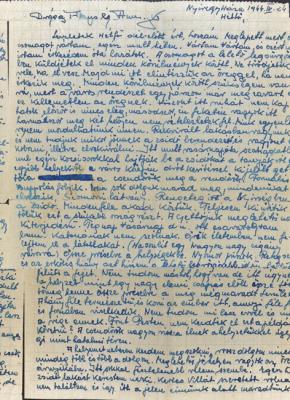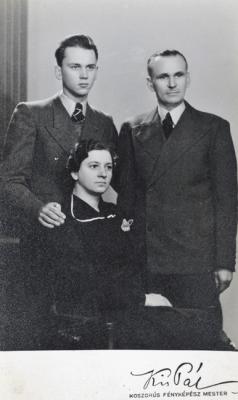On 24 April 1944, Lajos Pásztor, a soldier in the Hungarian army stationed at an army base in Nyíregyháza, in North East Hungary, wrote to his parents in Budapest:
Dear Mother and Father,
I don’t know when we will be released from this place; the situation here is catastrophic. The number of Jews arriving here is horrifying, both because of the overcrowded conditions and because of the lack of sanitation. The scenes are shocking. I think that they are planning to empty the country of Jews. It seems that their intention is to erase them.
We are not allowed to leave our base, but we can see the overcrowding and pressure that they are under on the other side. There are gypsies there too. I don’t know if this is the case in other places as well and I don’t know how this will end. Is it like this in Budapest too? Have they adopted this negative model there as well?
Ten days earlier, on 14 April 1944, the Germans had begun to transfer Jews from the surrounding villages to the few streets in Nyíregyháza that had been designated as a ghetto. The Jews of Nyíregyháza were moved into the ghetto on the day that Lajos wrote the letter to his parents. The overcrowding that Lajos described in the ghetto was severe: some 11,000 people were forced into just 123 houses. The food shortage was particularly acute because the Jews who had been deported from the surrounding villages – over half the ghetto inhabitants – had not been permitted to bring food with them.
At the same time that Lajos the soldier was being shocked by the inhuman conditions in the Nyíregyháza ghetto, his parents, Lajos and Lajosne, were involved in the rescue of Jews in Budapest, together with the Poór family that lived in their building. The Poór family owned a fabric store and the two families hid Gyula Kaufman – one of Miklos Poór’s Jewish employees – along with his brother, sisters and six other Jews in the shop. The Poór and Pásztor families provided them with food and when the risk of discovery increased, they moved them to the basement of the building and from there to a more secure hiding place.
After the war, Lajos returned to Budapest and married Mogda. Gyula Kaufman married Magda Neuman, a survivor of Auschwitz who had married after the war and was widowed shortly thereafter. Gyula was a father to Orna, Magda’s daughter from her first marriage.
Gyula Kaufman and his family remained in close contact with his rescuers. Gyula ensured that the Poór and Pásztor families were recognized as Righteous Among the Nations, and in 1991 Lajos and Mogda Pásztor visited Yad Vashem to accept the award on behalf of Lajos’s parents, who had passed away.
Lajos died a number of years ago. The strong connection between Mogda and Orna continues to this day. On one of Orna’s visits to Mogda, Mogda gave her the letter that her husband Lajos had sent his parents in Budapest while he was a soldier serving in the Hungarian army.
The bleak forecast of the German’s intention to “erase the Jews” predicted by Lajos in his letter, came about exactly as he had feared. On 12 May 1944, the deportation of Jews from the Nyíregyháza ghetto to Auschwitz began. The deportations continued until the end of that month. Few returned from Auschwitz after the war. The Pásztor family was among the minority that refused to accept the fate that had been decreed for the Jews, and whose courage and humanity was revealed in those dark days.








